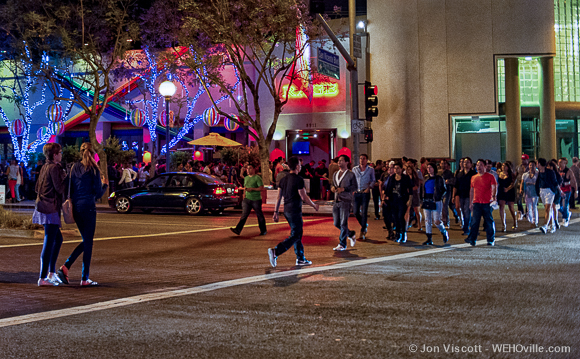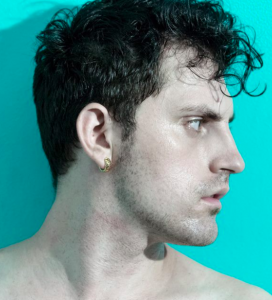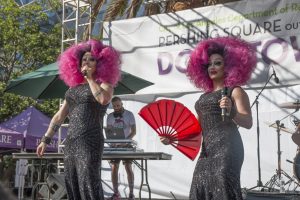
Since the 1920’s, West Hollywood and nightlife have enjoyed a symbiotic relationship. Under the lax jurisdiction of the L.A County Sheriffs Department, the unincorporated Los Angeles neighborhood attracted droves of Prohibition-era revelers to its Sunset Strip casinos and speakeasies. It also provided sanctuary for L.A.’s LGBT forefathers fleeing the homophobic purview of the Los Angeles Police Department.
Nearly a century later, positive media representation and civil rights victories such as marriage equality have thrust the queer community into the mainstream. This evolving LGBT identity is reflected in the current state of West Hollywood’s nightlife, which, according to a 2014 L.A. Times article, is beginning to skew towards a more heteronormative demographic:
“West Hollywood has seen a development boom that has made the city a more hip, but not necessarily more gay, address. While the city’s gay population has remained at about 40% for some time, the commercial scene is changing. The city’s last lesbian bar, The Palms, was razed last year because the property owners wanted to develop the site, where an upscale supermarket has been proposed.”
This trend is most notable at Robertson Boulevard’s iconic bar and restaurant The Abbey, where over the past few years queer patrons have competed with squads of straight party girls looking to tap into the fabulation of gay nightlife. This female invasion got so bad that back in 2012, Abbey owner David Cooley declared an edict banning bachelorette parties at the establishment. Although it was proposed as a protest against the now overruled Prop 8 gay marriage ban, blogger Louis Pietzman posited another motivation for the decision.

“Here’s what Cooley isn’t saying,” Pietzman wrote on a Gawker post, “bachelorette parties at gay bars are f–king annoying… And it’s unique to straight women and gay men. Straight men wouldn’t celebrate a bachelor party at a lesbian bar. I mean, they might try, but I’m not sure how well that would go over.”
Cooley’s newest endeavors, annexing former gay bar Here Lounge and turning it into The Chapel, as well as partnering in the opening of a second Bottega Louie location on Santa Monica Boulevard, have, according to an article on WEHOville in June, “prompted a debate among those who argument that it’s another step in the collapse of Boystown as a gay destination.” David Cooley argues that this diversification of the gayborhood is a positive trend.
“I just don’t understand why people who claim to love their community think a world-class dining destination like Bottega Louie will harm their community,” said Cooley. “There is this pernicious idea that in order to be a gay bar, we need to exclusively have gay clientele, which is exactly the type of discrimination we’ve all fought against. West Hollywood has always been about inclusion and diversity. Isn’t a good thing to see gay, straight, bisexual and trans people all at the same club having a good time together?”
For Cooley, this perceived heterophobia reflects his biggest criticism of West Hollywood nightlife.
“There is a vocal group in the community that thinks there is a specific way that you have you to be gay, or measures ‘how gay’ things are,” he said. “Everybody should always be welcomed. There is no one-way to be gay.”
Conversely, some, such as Jayk Knight, feel WeHo nightlife needs to embrace its queer identity more firmly.
“My biggest criticism of WeHo nightlife is that in general, it’s afraid to be really gay and afraid to try new and different ideas,” said the 27-year-old go-go dancer. “That is not necessarily a criticism just of promoters, managers, or owners. A lot of patrons, I think, are afraid to really be gay and express themselves.”

For Knight, this trend is a side effect of the LGBT community’s nascent mainstream status.
“The gay community is at a strange place right now. I see a large camp of gay men who seem to strive for the heterosexual ideas of the 1950s and 1960s, the nuclear family. I’m not sure we’re necessarily moving forward as a group. Because we’re not thinking forward and not confident enough to be ourselves. We’re in ‘the spotlight’ so we feel we have to be on our best behavior and in our Sunday best. But is that helping anyone?”
A result of WeHo’s inclination towards playing it safe is the recent downtown migration of queer L.A.’s edgier party patrons. New gay watering holes like Precinct, Redline and Bar Mattachine offer an alternative to the cookie cutter boys town bar scene.
“Christ, lately its like, ‘Oh WeHo, I don’t go there’ or ‘Downtown is it,’ quipped long time nightlife notable Billy Francesca. “Yes, downtown is more cutting edge. Its about the performers bringing a voice.”
Most vocal within DTLA’s queer nightlife movement is the drag duo the Boulet Brothers, whose “Queen Kong,” a weekly island of misfit toys hosted at Precinct, was coronated ‘Best New Gay Gay Party’ by L.A. Weekly. The couple cut their teeth in L.A. nightlife with the pansexual extravaganza “Miss Kitty’s,” originally housed in WeHo’s Bar Lubitsch, then known as the Parlour, before they relocated it to Hollywood’s Dragonfly. The Boulets continued traveling eastward, eventually carving a niche in the burgeoning DTLA scene.
“The nightlife in Downtown is raw, vital, creative and free. It’s not 100% safe, but you can feel the freedom and wild abandon in it,” said Dracmorda Boulet, the taller of the two.
“It’s not about bottle service and booths and security guards with earpieces,” added his consort Swanthula.

This desire for creativity in queer nightlife can be seen in other L.A. Weekly “Best of LA” winners. Gym Bar, recipient of this year’s “Best Gay Jock Bar,” is lauded for its unique premise and ability to provide a sports sanctuary for the LGBT community. Similarly, Flaming Saddles, winner of 2015’s ‘Best Gay Cowboy Bar’ accolade, was praised for offering “an alternative to the usual spaces full of shirtless boys dancing to the same pop-diva remixes.” Ironically, when it opened last year, many predicted that a queer country music saloon run by a straight couple wouldn’t last 6 weeks.
“When we opened in New York City there was no other reference for a gay cowboy bar, so everyone came with no preconceived idea of what it would be,” explained Chris Barnes, who opened Flaming Saddles locations in New York and Los Angeles with his long-time girlfriend Jacqui Squatriglia. “L.A. has Oil Can Harry’s (in Studio City), and I think everyone got the impression WeHo was getting an Oil Can Harry’s, which we are not. I think once you experience Flaming Saddles WeHo you realize we fit in just fine.”
The success of Flaming Saddles can be attributed to its ability to adapt, adventuring beyond its initial country roots to add theme nights and events, most notably the return of popular dance party Fresh Fridays.
“Our first year plan was to mount our bar and establish our base, with a strong drink, great service and dance,” explained Squatriglia. “Our philosophy has always been as we draw near, more will be revealed, and we would hold off making any changes till after one year. What was revealed, was that we have a lot of space to fill physically, and that meant taking our Cowboy-a-Go Go base and adding more horsepower, so we just punched up the energy where we needed it.”
When it comes to punching up WeHo, the couple invokes the yearning for more creativity and artistry, specifically in the physical aesthetic of the neighborhood.
“My biggest criticism of WeHo nightlife is the lack of physical identification of these three blocks of Santa Monica Boulevard from Palm to Robertson,” said Barnes. “This is a powerful historical setting that must be celebrated visually, we just feel there should be a vibrant artistic decor. It should be more than the neon lights of the clubs. This is Hollywood for Christ sake. This is the visual medium capitol of the world.”
As with every other aspect of his life, Francesca wants to take this concept of adding an artistic element to WeHo nightlife and amp it up to the nth degree by transforming the gayborhood into a fully realized block party.
“Jesus Mary and Joseph! Bring the best of each club, shut down Santa Monica Boulevard once every six months for a party with all the DJs, dancers, and promoters,” Francesca said. “Do it for fun, not for ‘Pride,’ not for ‘politics.’ Donate some money to a safe house for gay teens. BAM! Community feels great, and the world looks at us like, ‘Damn, WeHo is legit!’”

Remembering the old West Hollywood of the late 1980’s into the 1990’s and beyond, “Boys Town” was my home for 20 years before artistic ambitions took me to New York City. I recall the good old days of the Faultline, the Revolver, Mother Lode Sunday beer busts and the Halloween celebration long before it became a moneymaking event for the city. Straight women came on occasion, and if there was an occasional bachelorette party, nobody noticed or cared. But when the Abbey came in and Sex in the City gained a cult status, all of a sudden, it was open… Read more »
I’m a veteran of the ‘original’ bars (the Raven on SM Blvd. in the City of LA)… and remember ‘why’ we focused on the more-benign LA Sheriff’s West Hollywood ‘protection’. I also lived in San Francisco briefly, then NYC and Ft. Lauderdale; all of which have had the traditional ‘gayborhoods’ gentrified over time; which pricing and our own property improvements brought along (most areas were fairly shabby and good opportunities for long-term investment then; I speak of not just WeHo; but South of Market (beyond just Castro); the West Village (hardly at all ‘gay’ now); and Wilton Manors (mostly retired… Read more »
WeHo -yawn… I’m opting for the bars and scene in DTLA!
My prediction is that in 5-10 years, WeHo will become another bland, generic hetero village like Brentwood. All the gays will move out and seek a new neighborhood, The city will lose all of its charm and cache once the gays leave. The city has made it clear that they are now catering to the majority rather than the minority group – even though it was the gay population that built this city and made it what it is today. – Thanks Weho for turning your back on the gay residents. I have lived in WeHo for quite some time… Read more »
Two sidebar comments: 1) did anyone else notice this article focused mostly on – and quoted heavily from – two bars owned/operated and frequented by stereotypical pretty-boy white men? 2) I totally agree with 90069: those rainbow crosswalks could use a good powerwashing. But I digress… To quote Angela Lansbury, “Tale as old as time…” The town is ALWAYS changing! – Here’s a CNN article from 5 years ago: http://www.cnn.com/2011/LIVING/03/07/west.hollywood.blues/ – Here’s a NY Times article from 9 years ago: http://www.nytimes.com/2007/10/30/us/30gay.html Yes, the Abbey is full of straight people (except the Chapel: it’s full of bottle service and a dance… Read more »
C.R., *WHAT* conservative residents? The hetero millennials who’ve moved in because it’s safe to walk our streets??
Do you know where David Cooley goes out? In Montreal. He has an apartment there.
Their gay neighborhood has naked male strip clubs that only allow women in one night a week. Gay Montreal has embraced and defended their turf. Cooley takes his money and spends it at REAL gay bars & clubs.
To kayaytche, as anyone who has been paying attention could see, Flaming Saddles had to adapt to the WeHo trappings because it was not working and would have been closed by now had they not done so. Most people did not like the format when they first arrived. The real issue here is that even though straights now feel comfortable in WeHo, sadly at the same rate, gays are not embraced in heteronormative nightlife spots in other parts of L.A. It’s nowhere near an equal tradeoff, If you go to bars in Hermosa and act like you are at Micky’s… Read more »
Maybe, now when we all know the facts, it is not a “BOYSTOWN” it’s all a FANTASY (lala) Town, or let call it GREEN (MONEY) TOWN.
We GAY MEN, should be all so happy, we wanted equality, we got it!
“[A]n alternative to the usual spaces full of shirtless boys dancing to the same pop-diva remixes.” Has the author even been to Flaming Saddles?!
Here are two things that could be done to help “Boystown” retain its gay identity. 1) We need more plaques, art, murals, rainbow flags and an official city designation of this area as “boystown” (with signage), as it has that historical significance. When I go to the Castro, I see similar things, and I feel like I’m truly in a gay neighborhood, in all respects (not just the bars). Our rainbow crosswalks were a nice start, but let’s celebrate the gay history that this strip of WeHo represents even more. 2) As covered in this article, WeHo needs a sprinkling… Read more »
What…you want David Cooley to hang a sign up that says “gays only”? Thats ridiculous. Maybe selling to SBE did take some of the local gay establishment aspect out of it…but even before that it was listed at the #1 gay bar in the world. So of course you had people from around the world (gay, bi or str8) wanting to see it. Integration is part of equality. I see no way around this unless you specifically cater an establishment to the “gay” or male focused patron….like naked men dancing, sleazy porn shown on the big screens, etc..so that no… Read more »